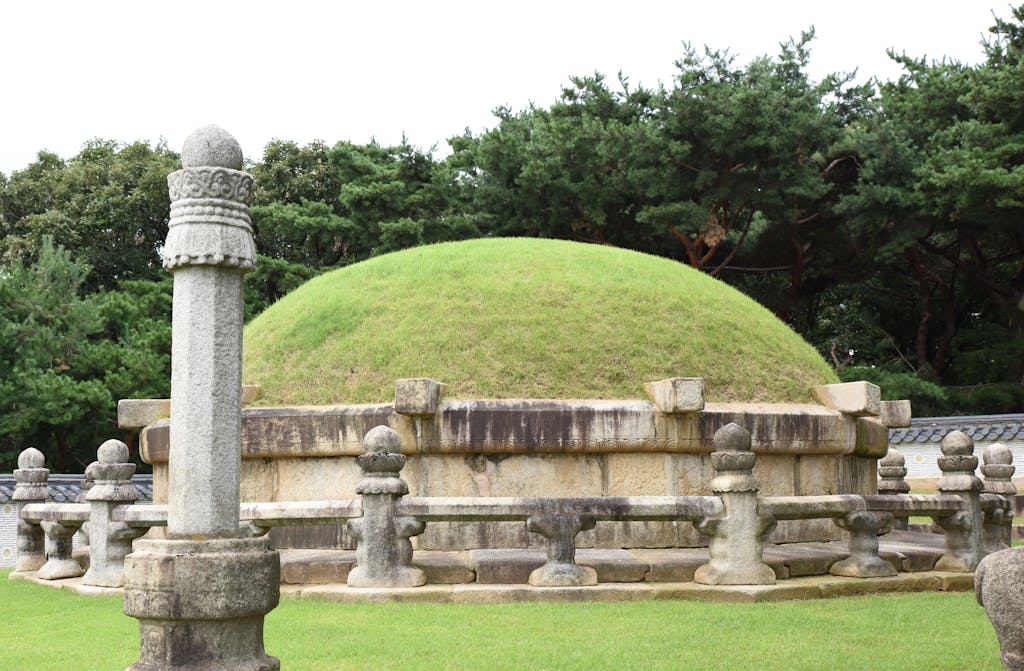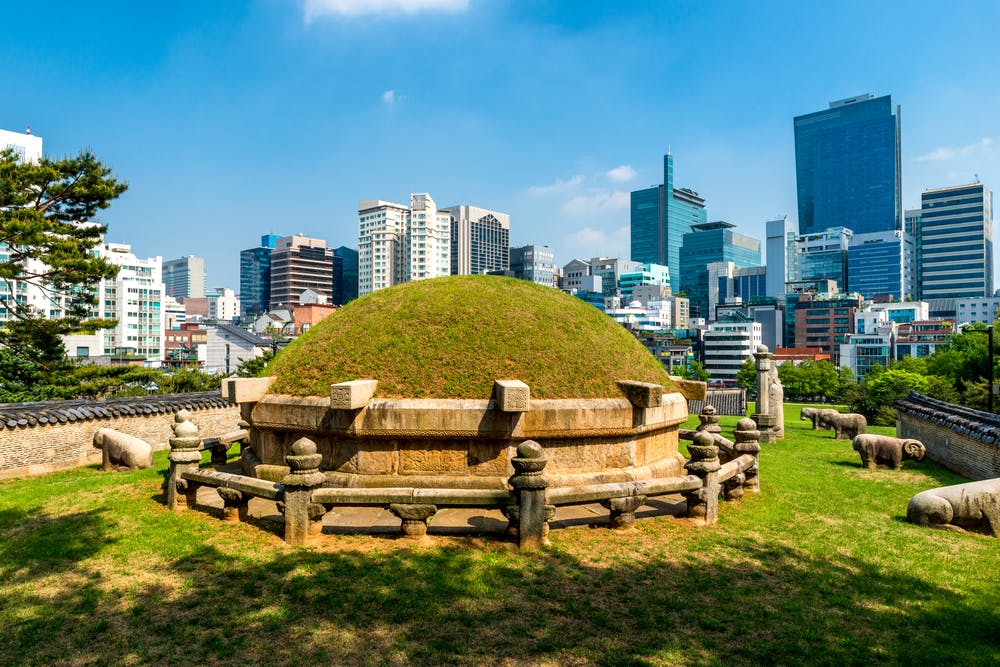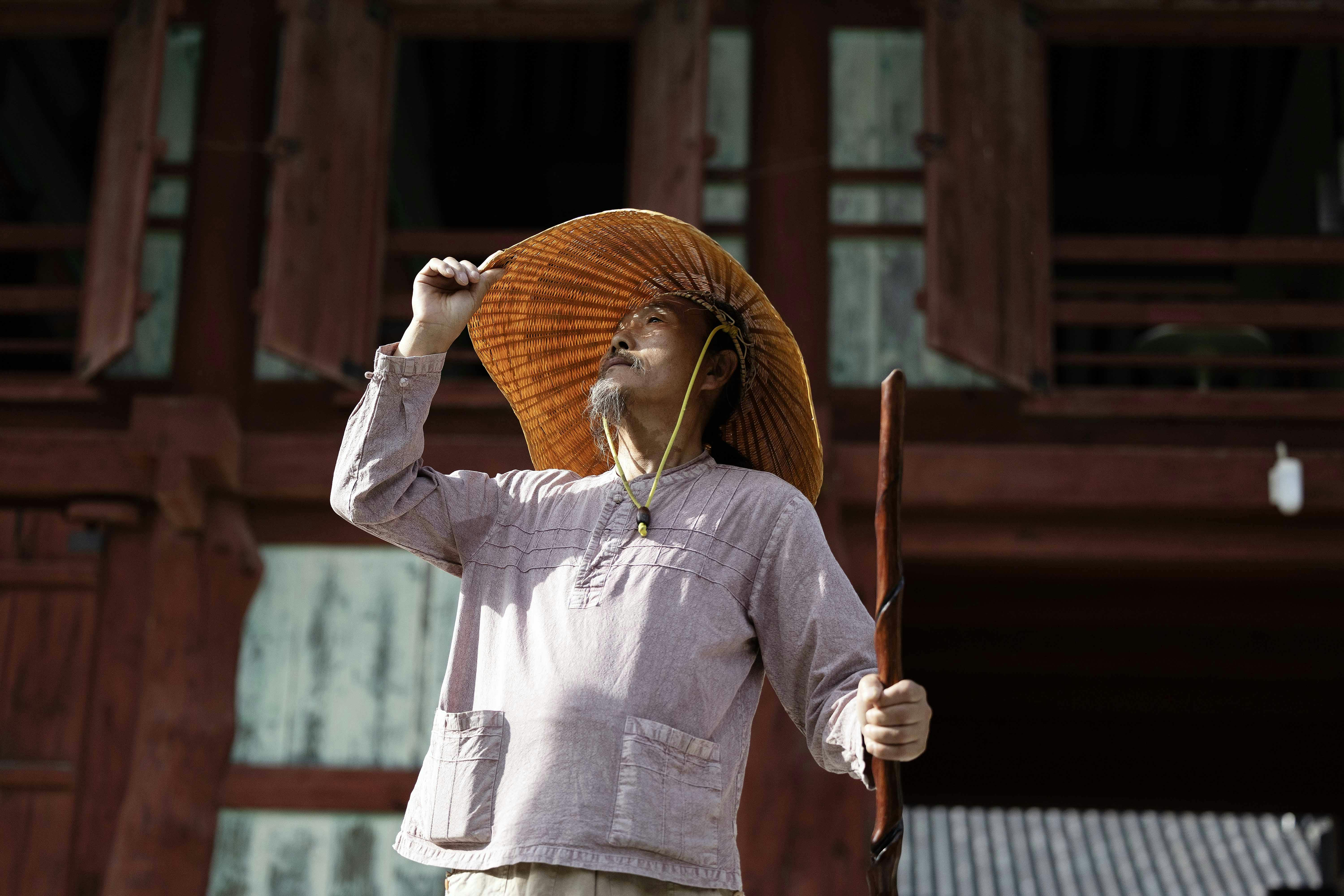Travel to Korea to Uncover South Korea’s Buried Seoul
In a quiet park near Gangnam’s massive COEX shopping mall, a dirt trail leads me through tall trees. Soon this forest thins to reveal a Hongsalmun, a red, spiked arch that commonly forms the entrance to Korean sacred sites. I follow a cobblestone path through this gate to a T-shaped Jeongjagak shrine, decorated in a manner that emphasizes its importance. It’s for moments like these that I travel to Korea.
The floral and geometric patterns on its beams are elements of Dancheong, a 2,000-year-old Korean design system used to embellish royal structures. This shrine offers spiritual protection to an adjacent grassy hump guarded by stone statues of Korean warriors.
Embedded in that mound are extraordinary tales of bloody battles, Imperial coups and the building of a nation. Not to mention the remains of 15th-century Korean king Seongjong. This place is called Seonjeongneung park, home to the tombs of Seongjong, his wife, Queen Jeonghyeon, and 16th-century king Jungjong.

While travelers flock to Seoul’s UNESCO-listed palaces, I saw few other foreigners at Seonjeongneung. Yet the Joseon tombs are revered by South Koreans, according to John P. DiMoia, associate professor of Korean History at the Seoul National University.
In Seoul’s ritzy Gangnam district, three grassy mounds are surrounded by skyscrapers, five-star hotels, and Michelin-starred restaurants. What’s buried within those humps helps explain this prosperity.
It is part of perhaps South Korea’s most overlooked UNESCO World Heritage Site, the Royal Tombs of the Joseon Dynasty (1392-1910), a kingdom that created key aspects of this nation’s culture and paved the way for its modern success. Built between 1408 and 1966, this collection of 40 well-preserved tombs is spread across 18 locations in the country’s northwest. The site should be on every visitor’s list of what to do in Seoul.
Even as South Korea has accelerated into the future, the Joseon Dynasty has remained “central to Korean identity,” DiMoia explains. That is because there are Joseon imprints all over the nation, from language to art, science and government.
“Joseon Kings are associated with significant Korean cultural developments,” he says, referring to their role in birthing or refining the Korean alphabet, ceramic arts, tea ceremonies and garden design. They also oversaw “the development of new approaches to technology like water clocks and astronomical observations.”
Understanding modern Korea

To understand modern South Korea, then, it helps to know the Joseon Dynasty. By the late 1300s, the preceding Goryeo Dynasty (918 – 1392 AD) had become destabilized by domestic conflicts and foreign invasions. A warrior who had helped defend the nation, Yi Seong-gye, then overthrew Goryeo, founded Joseon and enacted major change.
The new king shifted the national capital to Seoul. There he built what are now two of the city’s chief tourist attractions — the colossal Gyeongbokgung Palace and the majestic Jongmyo shrine. His Joseon successors oversaw the blooming of this nation, as it established sophisticated governance and made breakthroughs in surveying, mapmaking, mathematics and astronomy.
Even the words that now roll off Korean tongues originated in this era. One of the most appealing Joseon tombs houses King Sejong, who created the Korean alphabet Hangul. Located 50 kilometers southeast of Gangnam, on the southern bank of the Han River, it is very similar in design to the tombs at Seonjeongneung Park.
A shrine and soldier statues protect the grassy mound that houses Sejong, widely considered Korea’s greatest king. His reign, from 1419 to 1450, saw the expansion of Korean territory and the invention of the sundial and udometer rain gauge.
How to find other Joseon tombs in Seoul

Most of the other Joseon tombs are in the northern suburbs or northern outskirts of Seoul. To the uninformed observer, they may appear scattered at random. In reality, their locations were precisely picked using Pungsu. A Korean equivalent of China’s Feng Shui, this system determines how spaces should be arranged to create harmony between humans and their surroundings. Many of the Joseon tombs were positioned with a hill to their rear, offering natural protection, and facing south toward water, with mountains visible in the distance.
Pungsu also dictated the minimalism of these tombs. They are not huge structures that dominate their environment, like the hulking Ho Chi Minh Mausoleum in Vietnam’s Hanoi, or giant Humayun’s Tomb in India’s New Delhi. Instead of making the Joseon tombs prominent because of sheer size, the Koreans achieved this by surrounding each with generous open space.
Almost six decades since the last of these tombs was built, the Joseon kings are honored annually by a grand event. Tourists who travel to Korea and visit Seoul on the first Sunday in May can witness Jongmyo Daeje, which involves a parade of more than 1,000 people dressed in colorful, loose-fitting Joseon outfits. This procession begins at the capital’s largest palace, Gyeongbokgung, and ends at the 14th-century Jongmyo Shrine.
Along the way, it pierces a cutting-edge cityscape that embodies the success of modern South Korea, the foundation for which was laid by the Joseon kings who now rest inside those 40 royal tombs.
Is travel to Korea in your future? Discover both ancient and modern wonders on a cruise to South Korea.
Ronan O’Connell is a journalist and photographer with 16 years’ experience as a reporter. He has contributed to more than 70 magazines and newspapers around the world including BBC, CNN, Forbes, The Guardian, San Francisco Chronicle, Travel + Leisure, The Independent, Toronto Star, South China Morning Post, Australian Financial Review etc. His travel writing and photography work have taken him to more than 60 countries.




















